11 April 2014 (Fillmore Auditorium, Denver CO)
A Thousand Faces and a thousand stories. Beats Antique took to Kickstarter last year to raise money, not for their planned album, A Thousand Faces, but to create a world class show to tour their new album. Showmanship has always been key for this exotic electronic group. While their music is heavily produced and full of intriguing layers of sound from around the world, their shows are rituals of tribal dance fusion driven by insistent rhythms and spectacle.
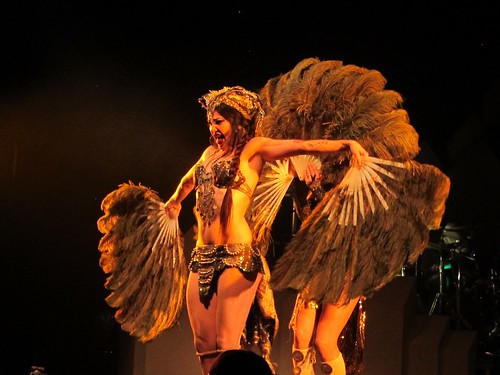 Choreographer and belly dancer Zoe Jakes deserves a lot of the credit for shaping the band’s stage presence. When I first saw the group in 2011, I was entranced by her dancing, which not only provided a context for the tunes, but also inspired the audience to abandon themselves to the physicality of the music. Jakes and her partners, David Satori and Sidecar Tommy Cappel, balanced at a nexus of rave, cultural outreach and ritual. The Fillmore was several times larger than that 2011 concert venue, and the new show took full advantage, delivering an overwhelming spectacle that rivaled any big pop band production. The Kickstarter money was well-spent on video projection technology from Obscura Digital, top-notch lighting and, of course, alluring costumes and choreography.
Choreographer and belly dancer Zoe Jakes deserves a lot of the credit for shaping the band’s stage presence. When I first saw the group in 2011, I was entranced by her dancing, which not only provided a context for the tunes, but also inspired the audience to abandon themselves to the physicality of the music. Jakes and her partners, David Satori and Sidecar Tommy Cappel, balanced at a nexus of rave, cultural outreach and ritual. The Fillmore was several times larger than that 2011 concert venue, and the new show took full advantage, delivering an overwhelming spectacle that rivaled any big pop band production. The Kickstarter money was well-spent on video projection technology from Obscura Digital, top-notch lighting and, of course, alluring costumes and choreography.
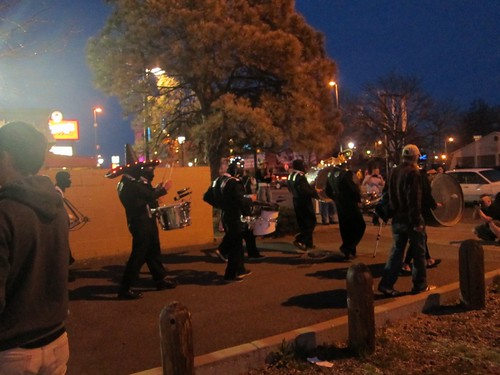 The opening acts each found their own contact points with the Beats Antique experience. Denver’s Itchy-O Marching Band paraded around the outside of the venue with their chaotic electro-rhythmic blare before making their entrance through the main doors. Their bright and blinking uniforms couldn’t offset the dark menace of their masked faces.
The opening acts each found their own contact points with the Beats Antique experience. Denver’s Itchy-O Marching Band paraded around the outside of the venue with their chaotic electro-rhythmic blare before making their entrance through the main doors. Their bright and blinking uniforms couldn’t offset the dark menace of their masked faces.
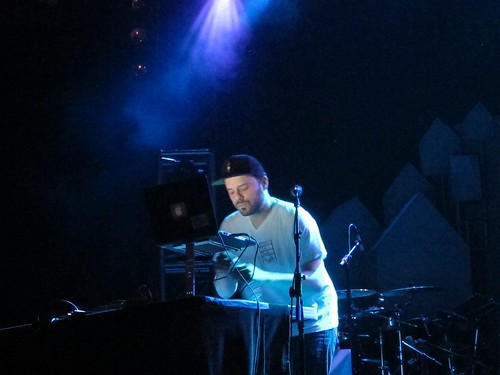 In contrast, producer/DJ Blockhead (Tony Simon) didn’t try to compete visually. Instead, he kicked off his set with a spooky riff full of intensely layered percussion. The sound of spirits in the shadows and foreign scales suited Beats Antique’s sonic palette, but he went on to evolve long-form pieces, moving through dance, sexy R&B and jazz before returning to the stranger tones he started with. His sample selections—a well-placed and mutated bit of “The Lion Sleeps Tonight,” a jazzy take on “Sunny” against a moody soul groove—sprinkled tasty little surprises throughout his set.
In contrast, producer/DJ Blockhead (Tony Simon) didn’t try to compete visually. Instead, he kicked off his set with a spooky riff full of intensely layered percussion. The sound of spirits in the shadows and foreign scales suited Beats Antique’s sonic palette, but he went on to evolve long-form pieces, moving through dance, sexy R&B and jazz before returning to the stranger tones he started with. His sample selections—a well-placed and mutated bit of “The Lion Sleeps Tonight,” a jazzy take on “Sunny” against a moody soul groove—sprinkled tasty little surprises throughout his set.
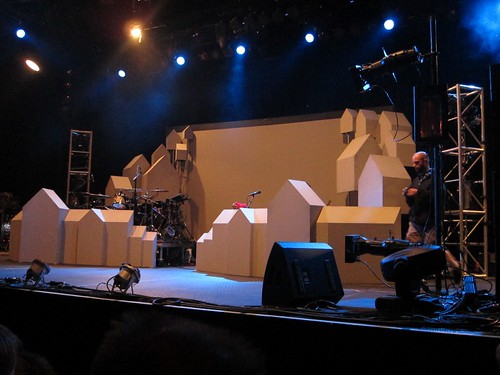 Before Beats Antique began their show, their stage was filled with boxy blocks that looked like a collection of white birdhouse blanks. Along with the backing scrim, these would become screens for the video projection. Cappel’s drum kit was behind and above one line of blocks while Satori’s collection of instruments was set behind the other. As the music started, these boxes became a small village with a large gnarled tree in the town square. The effect was strong, with Cappel and Satori embedded within the scene. The music was a blend of live instrumentation and pre-recorded parts. So, in addition to his other gear, Satori played producer, mixing parts into the song. As the tune built up energy, the projection turned psychedelic, flashing swirls of high contrast op-art over the stage, but still preserving the tree as a centerpiece.
Before Beats Antique began their show, their stage was filled with boxy blocks that looked like a collection of white birdhouse blanks. Along with the backing scrim, these would become screens for the video projection. Cappel’s drum kit was behind and above one line of blocks while Satori’s collection of instruments was set behind the other. As the music started, these boxes became a small village with a large gnarled tree in the town square. The effect was strong, with Cappel and Satori embedded within the scene. The music was a blend of live instrumentation and pre-recorded parts. So, in addition to his other gear, Satori played producer, mixing parts into the song. As the tune built up energy, the projection turned psychedelic, flashing swirls of high contrast op-art over the stage, but still preserving the tree as a centerpiece.
 The imagery shifted for each song, becoming a Southeast Asian temple for Jakes’ first dance. Later, we’d appreciate the versatility of the set up as it transitioned through a mind-blowing collection of tableaux: retro Asian pen-and-ink animations, a game show set, a giant snake’s lair and a video game battlefield among others. The set designers did a fantastic job of delivering this variety without letting the technology become the focus. It was easy to forget the initial blocky appearance and become immersed in the show. Similarly, the set and live instrumentation distracted from the technical aspects of the backing tracks.
The imagery shifted for each song, becoming a Southeast Asian temple for Jakes’ first dance. Later, we’d appreciate the versatility of the set up as it transitioned through a mind-blowing collection of tableaux: retro Asian pen-and-ink animations, a game show set, a giant snake’s lair and a video game battlefield among others. The set designers did a fantastic job of delivering this variety without letting the technology become the focus. It was easy to forget the initial blocky appearance and become immersed in the show. Similarly, the set and live instrumentation distracted from the technical aspects of the backing tracks.
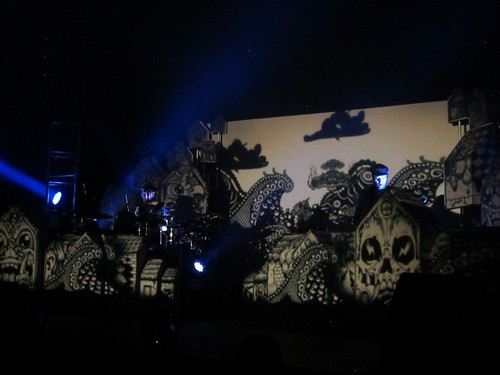
Jakes’ stage craft also played a strong part. Her mesmerizing movements created a focal point and storyline for the songs to hang on. Aside from belly dancing and modern interpretive dance, she used elements of Kabuki, Balinese dance and other cultural traditions. She was stylized and theatrical, but still drew on an earthy physicality. One of the strongest moments came during “Viper’s Den.” Her costume simulated snakeskin with a slinky sheath and cobra-like headpiece. After writhing around in sinuous seduction, she melted back into the set and another dancer enveloped her from behind, hiding her from view. Suddenly, the pair unfolded and revealed Jakes’ costume change. Her dress and headpiece were gone, and the two were decked out as fan dancers. Where her earlier expression had been wicked and intense, now she played the tease with broad bawdiness.
 Even the campier tunes from A Thousand Faces played well. During the game show pastiche “Doors of Destiny,” a volunteer took his chances picking one of three doors to receive either “Eternal damnation, everlasting life or unlimited bandwidth and one year’s free technical support.” Of course, that didn’t go well, and he was attacked by a giant inflatable demon during the song’s glitch-step grinding climax. Later, Beats Antique performed their song “Beelzebub” with a pre-recorded Claymation by Les Claypool.
Even the campier tunes from A Thousand Faces played well. During the game show pastiche “Doors of Destiny,” a volunteer took his chances picking one of three doors to receive either “Eternal damnation, everlasting life or unlimited bandwidth and one year’s free technical support.” Of course, that didn’t go well, and he was attacked by a giant inflatable demon during the song’s glitch-step grinding climax. Later, Beats Antique performed their song “Beelzebub” with a pre-recorded Claymation by Les Claypool.
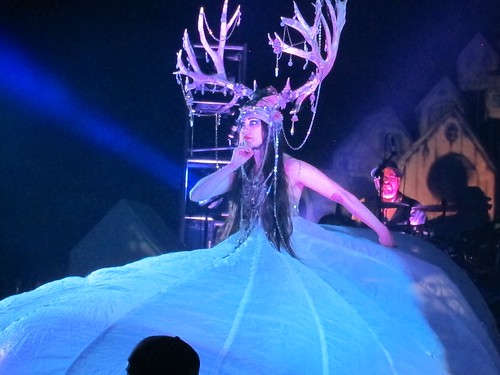 The overwhelming spectacle, exotic music and visceral bass punch contributed to the rave atmosphere. Dozens of Zoe acolytes danced their own steps, and every third person wore some kind of crazy outfit. The audience often competes with the stage at this kind of show, but glow sticks and LED displays merely added ambiance.
The overwhelming spectacle, exotic music and visceral bass punch contributed to the rave atmosphere. Dozens of Zoe acolytes danced their own steps, and every third person wore some kind of crazy outfit. The audience often competes with the stage at this kind of show, but glow sticks and LED displays merely added ambiance.
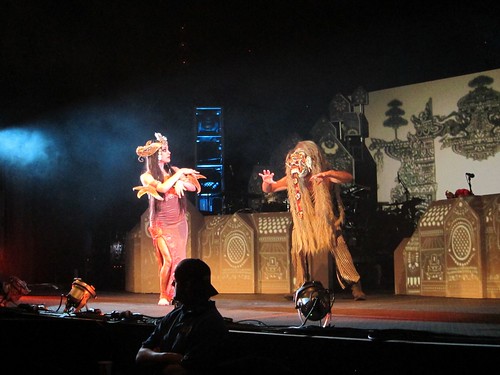 More photos on my Flickr.
More photos on my Flickr.
A Thousand Faces and a thousand stories. Beats Antique took to Kickstarter last year to raise money, not for their planned album, A Thousand Faces, but to create a world class show to tour their new album. Showmanship has always been key for this exotic electronic group. While their music is heavily produced and full of intriguing layers of sound from around the world, their shows are rituals of tribal dance fusion driven by insistent rhythms and spectacle.
 Choreographer and belly dancer Zoe Jakes deserves a lot of the credit for shaping the band’s stage presence. When I first saw the group in 2011, I was entranced by her dancing, which not only provided a context for the tunes, but also inspired the audience to abandon themselves to the physicality of the music. Jakes and her partners, David Satori and Sidecar Tommy Cappel, balanced at a nexus of rave, cultural outreach and ritual. The Fillmore was several times larger than that 2011 concert venue, and the new show took full advantage, delivering an overwhelming spectacle that rivaled any big pop band production. The Kickstarter money was well-spent on video projection technology from Obscura Digital, top-notch lighting and, of course, alluring costumes and choreography.
Choreographer and belly dancer Zoe Jakes deserves a lot of the credit for shaping the band’s stage presence. When I first saw the group in 2011, I was entranced by her dancing, which not only provided a context for the tunes, but also inspired the audience to abandon themselves to the physicality of the music. Jakes and her partners, David Satori and Sidecar Tommy Cappel, balanced at a nexus of rave, cultural outreach and ritual. The Fillmore was several times larger than that 2011 concert venue, and the new show took full advantage, delivering an overwhelming spectacle that rivaled any big pop band production. The Kickstarter money was well-spent on video projection technology from Obscura Digital, top-notch lighting and, of course, alluring costumes and choreography.
Opening acts: Itchy-O Marching Band, Blockhead
 The opening acts each found their own contact points with the Beats Antique experience. Denver’s Itchy-O Marching Band paraded around the outside of the venue with their chaotic electro-rhythmic blare before making their entrance through the main doors. Their bright and blinking uniforms couldn’t offset the dark menace of their masked faces.
The opening acts each found their own contact points with the Beats Antique experience. Denver’s Itchy-O Marching Band paraded around the outside of the venue with their chaotic electro-rhythmic blare before making their entrance through the main doors. Their bright and blinking uniforms couldn’t offset the dark menace of their masked faces.
 In contrast, producer/DJ Blockhead (Tony Simon) didn’t try to compete visually. Instead, he kicked off his set with a spooky riff full of intensely layered percussion. The sound of spirits in the shadows and foreign scales suited Beats Antique’s sonic palette, but he went on to evolve long-form pieces, moving through dance, sexy R&B and jazz before returning to the stranger tones he started with. His sample selections—a well-placed and mutated bit of “The Lion Sleeps Tonight,” a jazzy take on “Sunny” against a moody soul groove—sprinkled tasty little surprises throughout his set.
In contrast, producer/DJ Blockhead (Tony Simon) didn’t try to compete visually. Instead, he kicked off his set with a spooky riff full of intensely layered percussion. The sound of spirits in the shadows and foreign scales suited Beats Antique’s sonic palette, but he went on to evolve long-form pieces, moving through dance, sexy R&B and jazz before returning to the stranger tones he started with. His sample selections—a well-placed and mutated bit of “The Lion Sleeps Tonight,” a jazzy take on “Sunny” against a moody soul groove—sprinkled tasty little surprises throughout his set.
 Before Beats Antique began their show, their stage was filled with boxy blocks that looked like a collection of white birdhouse blanks. Along with the backing scrim, these would become screens for the video projection. Cappel’s drum kit was behind and above one line of blocks while Satori’s collection of instruments was set behind the other. As the music started, these boxes became a small village with a large gnarled tree in the town square. The effect was strong, with Cappel and Satori embedded within the scene. The music was a blend of live instrumentation and pre-recorded parts. So, in addition to his other gear, Satori played producer, mixing parts into the song. As the tune built up energy, the projection turned psychedelic, flashing swirls of high contrast op-art over the stage, but still preserving the tree as a centerpiece.
Before Beats Antique began their show, their stage was filled with boxy blocks that looked like a collection of white birdhouse blanks. Along with the backing scrim, these would become screens for the video projection. Cappel’s drum kit was behind and above one line of blocks while Satori’s collection of instruments was set behind the other. As the music started, these boxes became a small village with a large gnarled tree in the town square. The effect was strong, with Cappel and Satori embedded within the scene. The music was a blend of live instrumentation and pre-recorded parts. So, in addition to his other gear, Satori played producer, mixing parts into the song. As the tune built up energy, the projection turned psychedelic, flashing swirls of high contrast op-art over the stage, but still preserving the tree as a centerpiece. The imagery shifted for each song, becoming a Southeast Asian temple for Jakes’ first dance. Later, we’d appreciate the versatility of the set up as it transitioned through a mind-blowing collection of tableaux: retro Asian pen-and-ink animations, a game show set, a giant snake’s lair and a video game battlefield among others. The set designers did a fantastic job of delivering this variety without letting the technology become the focus. It was easy to forget the initial blocky appearance and become immersed in the show. Similarly, the set and live instrumentation distracted from the technical aspects of the backing tracks.
The imagery shifted for each song, becoming a Southeast Asian temple for Jakes’ first dance. Later, we’d appreciate the versatility of the set up as it transitioned through a mind-blowing collection of tableaux: retro Asian pen-and-ink animations, a game show set, a giant snake’s lair and a video game battlefield among others. The set designers did a fantastic job of delivering this variety without letting the technology become the focus. It was easy to forget the initial blocky appearance and become immersed in the show. Similarly, the set and live instrumentation distracted from the technical aspects of the backing tracks.
Jakes’ stage craft also played a strong part. Her mesmerizing movements created a focal point and storyline for the songs to hang on. Aside from belly dancing and modern interpretive dance, she used elements of Kabuki, Balinese dance and other cultural traditions. She was stylized and theatrical, but still drew on an earthy physicality. One of the strongest moments came during “Viper’s Den.” Her costume simulated snakeskin with a slinky sheath and cobra-like headpiece. After writhing around in sinuous seduction, she melted back into the set and another dancer enveloped her from behind, hiding her from view. Suddenly, the pair unfolded and revealed Jakes’ costume change. Her dress and headpiece were gone, and the two were decked out as fan dancers. Where her earlier expression had been wicked and intense, now she played the tease with broad bawdiness.
 Even the campier tunes from A Thousand Faces played well. During the game show pastiche “Doors of Destiny,” a volunteer took his chances picking one of three doors to receive either “Eternal damnation, everlasting life or unlimited bandwidth and one year’s free technical support.” Of course, that didn’t go well, and he was attacked by a giant inflatable demon during the song’s glitch-step grinding climax. Later, Beats Antique performed their song “Beelzebub” with a pre-recorded Claymation by Les Claypool.
Even the campier tunes from A Thousand Faces played well. During the game show pastiche “Doors of Destiny,” a volunteer took his chances picking one of three doors to receive either “Eternal damnation, everlasting life or unlimited bandwidth and one year’s free technical support.” Of course, that didn’t go well, and he was attacked by a giant inflatable demon during the song’s glitch-step grinding climax. Later, Beats Antique performed their song “Beelzebub” with a pre-recorded Claymation by Les Claypool. The overwhelming spectacle, exotic music and visceral bass punch contributed to the rave atmosphere. Dozens of Zoe acolytes danced their own steps, and every third person wore some kind of crazy outfit. The audience often competes with the stage at this kind of show, but glow sticks and LED displays merely added ambiance.
The overwhelming spectacle, exotic music and visceral bass punch contributed to the rave atmosphere. Dozens of Zoe acolytes danced their own steps, and every third person wore some kind of crazy outfit. The audience often competes with the stage at this kind of show, but glow sticks and LED displays merely added ambiance. More photos on my Flickr.
More photos on my Flickr.

No comments:
Post a Comment